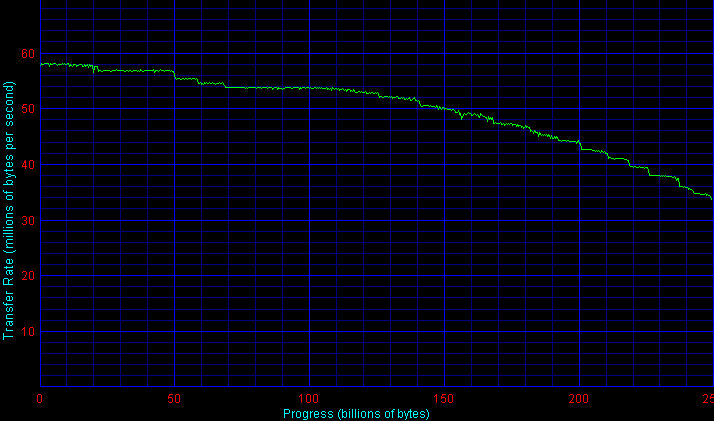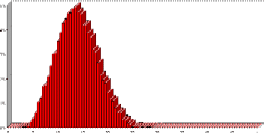|

With the slow but sure demise of drives spinning at 5400 RPM, varying buffer sizes are a way for manufacturers to distinguish between value and performance lines. Like its past brethren, the 2500JB comes to market with a counterpart that also features a smaller 2-meg buffer (WD2500BB). Given the relatively high cost of a 250-gigabyte drive to begin with, the small premium and considerable performance benefits that accompany the JB’s 8-megabyte buffer should be worth the additional price to all but the most cost-conscious consumers. Western Digital also backs the JB series with a more traditional three-year warranty rather than the BB series’ shorter one-year guarantee.

Low-Level ResultsFor diagnostic purposes only, StorageReview measures the following low-level parameters: Average Read Access Time– An average of 25,000 random accesses of a single sector each conducted through IPEAK SPT’s AnalyzeDisk suite. The high sample size permits a much more accurate reading than most typical benchmarks deliver and provides an excellent figure with which one may contrast the claimed access time (claimed seek time + the drive spindle speed’s average rotational latency) provided by manufacturers. WB99 Disk/Read Transfer Rate – Begin– The sequential transfer rate attained by the outermost zones in the hard disk. The figure typically represents the highest sustained transfer rate a drive delivers. WB99 Disk/Read Transfer Rate – End– The sequential transfer rate attained by the innermost zones in the hard disk. The figure typically represents the lowest sustained transfer rate a drive delivers. |
For more information, please click here.
|
Note: Scores on top are better. |
|
|||||||||||||||||||
|
|
||||||||||||||||||
According to AnalyzeDisk, the Caviar WD2500JB’s average read access time is 13.8 milliseconds. Subtracting 4.2 ms to account for the rotational latency of a 7200 RPM drive yields a measured average read seek time of 9.6 milliseconds. Though this figure represents a substantial improvement over the score turned in by the WD2000JB, it still fails to meet WD’s claimed 8.9 ms seek time.
The use of an external controller (the Promise Ultra133) and its associated driver unfortunately makes it more difficult to consistently disable write caching which unfortunately precludes us from presenting average write access times.
|
Note: Scores on top are better. |
|
|||||||||||||||||||||||||||||||||
|
|
||||||||||||||||||||||||||||||||
WD2500JB Transfer Rate
|
|||||||||||||||||||||||||||||||||
The WD2500JB’s outer-zone transfer rate weighs in at 57.7 MB/sec. While not a bad score in an absolute sense, it is merely an incremental improvement over its predecessor, indicating that the 2500JB’s improved areal density, at least in the drive’s outer tracks, comes from an increase in tracks per inch rather than sectors per track. Transfer rates decay a bit gradually, however, resulting in a respectable 36.2 MB/sec inner-zone showing.
Single-User PerformanceStorageReview uses the following tests to assess non-server use: StorageReview.com Office DriveMark 2002– A capture of 30 minutes of actual computer productivity use that exactingly recreates a typical office-style multitasking environment. The applications include: Outlook XP, Word XP, Excel XP, PowerPoint XP, Calypso (a freeware e-mail client), SecureCRT v3.3 (a telnet/SSH client), CuteFTP Pro v1.0 (an FTP/SSH client), ICQ 2000b), Palm Hotsync 4.0, Gravity 2.3 (a Usenet/newsgroups client), PaintShop Pro v7.0, Media Player v8 for the occasional MP3, and Internet Explorer 6.0. StorageReview.com High-End DriveMark 2002– A capture of VeriTest’s Content Creation Winstone 2001 suite. Applications include Adobe Photoshop v5.5, Adobe Premiere v5.1, Macromedia Director v8.0, Macromedia Dreamweaver v3.0, Netscape Navigator v4.73, and Sonic Foundry Sound Forge v4.5. Unlike typical productivity applications, high-end audio- and video- editing programs are run in a more serial and less multitasked manner. The High-End DriveMark includes significantly more sequential transfers and write (as opposed to read) operations. |
StorageReview.com Bootup DriveMark 2002– A capture of the rather unusual Windows XP bootup process. Windows XP’s boot procedure involves significantly different access patterns and queue depths than those found in other disk accesses. This test recreates Windows XP’s bootup from the initial bootstrap load all the way to initialization and loading of the following memory-resident utilities: Dimension4 (a time synchronizer), Norton Antivirus 2002 AutoProtect, Palm Hotsync v4.0, and ICQ 2000b.
StorageReview.com Gaming DriveMark 2002– A weighted average of the disk accesses featured in five popular PC games: Lionhead’s Black & White v1.1, Valve’s Half-Life: Counterstrike v1.3, Blizzard’s Diablo 2: Lord of Destruction v1.09b, Maxis’s The Sims: House Party v1.0, and Epic’s Unreal Tournament v4.36. Games, of course, are not multitasked- all five titles were run in a serial fashion featuring approximately half an hour of play time per game.
For more information, please click here.
|
Note: Scores on top are better. |
Like its predecessors, the Caviar WD2500JB takes its place at the top of today’s ATA drive heap. The margin of improvement that the 83 GB/platter 2500JB offers over the older 67 GB/platter 2000JB, however, is razor thin.
For example, the drive’s StorageReview.com Office DriveMark 2002 of 429 I/Os per second, rather than improving over the 2000JB’s showing, actually falls behind by an admittedly imperceptible 0.5% gap. In the other three Desktop DriveMarks, the 2500JB squeaks by the 2000BB by the same tiny margins.
Keep in mind that the 250-gig 2500JB enjoys a small advantage over the 2000JB in these tests due to its increased capacity. The former’s minute performance advantages would likely be erased were the two drives the same capacity. For all intents and purposes, despite its improved access times, the 2500JB’s desktop performance is identical to that of the 2000JB.
Multi-User PerformanceStorageReview uses the following tests to assess server performance: StorageReview.com File Server DriveMark 2002– A mix of synthetically-created reads and writes through IOMeter that attempts to model the heavily random access that a dedicated file server experiences. Individual tests are run under loads with 1 I/O, 4 I/Os, 16 I/Os, and 64 I/Os outstanding. The Server DriveMark is a convenient at-a-glance figure derived from the weighted average of results obtained from the four different loads. StorageReview.com Web Server DriveMark 2002– A mix of synthetically-created reads through IOMeter that attempts to model the heavily random access that a dedicated web server experiences. Individual tests are run under loads with 1 I/O, 4 I/Os, 16 I/Os, and 64 I/Os outstanding. The Server DriveMark is a convenient at-a-glance figure derived from the weighted average of results obtained from the four different loads. For more information click here. |
|
Note: Scores on top are better. |
|
|||||||||||||||||||||||||||||||||
|
|
||||||||||||||||||||||||||||||||
Though it delivers file server performance in line with that of the WD2000JB, the Caviar WD2500JB places some distance between itself and its predecessor in the read-intensive Web Server DriveMark 2002. In the end, however, those seeking to build a server on the cheap through utilization of an ATA drive may still be better served by the IBM Deskstar 180GXP.
Legacy PerformanceeTesting Lab’s WinBench 99 Disk WinMark tests are benchmarks that attempt to measure desktop performance through a rather dated recording of high-level applications. Despite their age, the Disk WinMarks are somewhat of an industry standard. The following results serve only as a reference; SR does not factor them into final judgments and recommends that readers do the same. |
|
Note: Scores on top are better. |
|
|||||||||||||||||||||||||||||||||
|
|
||||||||||||||||||||||||||||||||
Heat and NoiseIdle Noise– The sound pressure emitted from a drive measured at a distance of 18 millimeters. The close-field measurement allows for increased resolution between drive sound pressures and eliminates interactions from outside environmental noise. Note that while the measurement is an A-weighted decibel score that weighs frequencies in proportion to human ear sensitivity, a low score does not necessarily predict whether or not a drive will exhibit a high-pitch whine that some may find intrusive. Conversely, a high score does not necessarily indicate that the drive exhibits an intrusive noise envelope. Net Drive Temperature– The highest temperature recorded from a 16-point sample of a drive’s top plate after it has been under heavy load for 80 minutes. The figures provided are net temperatures representing the difference between the measured drive temperature and ambient temperature. For more information, please click here. |
|
Note: Scores on top are better. |
|
|||||||||||||||||||||||||||||||||
|
|
||||||||||||||||||||||||||||||||
Though it remains equipped with more traditional ball bearing motors as opposed to newer fluid dynamic bearing motor technology, the Caviar WD2500JB is nonetheless the first three-platter WD JB design to turn in an objectively-measured noise floor below 45 dB/A. Its score indicates that, when properly mounted in a sturdy case, the 2500JB’s spindle noise will likely be overshadowed by that of other system components. Seeks, likewise, are quite muted and unobtrusive.
The 2500JB’s net temperature after heavy use hovers just under 20 degrees Celsius, a score similar to all of the manufacturer’s recent three-platter designs. A properly-ventilated system should have no problems with this drive.
ReliabilityThe StorageReview.com Reliability Survey aims to amalgamate individual reader experiences with various hard disks into a comprehensive warehouse of information from which meaningful results may be extracted. A multiple-layer filter sifts through collected data, silently omitting questionable results or results from questionable participants. A proprietary analysis engine then processes the qualified dataset. SR presents results to readers through a percentile ranking system. According to filtered and analyzed data collected from participating StorageReview.com readers, the |
According to filtered and analyzed data collected from participating StorageReview.com readers, a predecessor of the
Western Digital Caviar WD2500JB, the
WD2000JB
, is more reliable than of the other drives in the survey that meet a certain minimum floor of participation.
Note that the percentages in bold above may change as more information continues to be collected and analyzed. For more information, to input your experience with these and/or other drives, and to view comprehensive results, please visit the SR Drive Reliability Survey.
ConclusionIn the end, despite its slightly higher areal density, the WD2500JB is really just a larger version of the WD2000JB. It delivers higher capacity mated to performance levels that the 2000JB has already released. The relationship between the two drives may be regarded much in the same way as the relationship (and similar performance) delivered between Maxtor DiamondMax Plus 9’s that feature varying platter sizes. |
This is not necessarily a bad thing; Western Digital’s confusing naming scheme makes it difficult for consumers to track down and purchase smaller, non-flagship drives featuring the latest areal densities and (presumably) performance. As the 2000JB-2500JB tandem and the DiamondMax Plus 9 series demonstrate, areal density continues to be a relative non-factor in driving today’s performance to higher levels.





 Amazon
Amazon